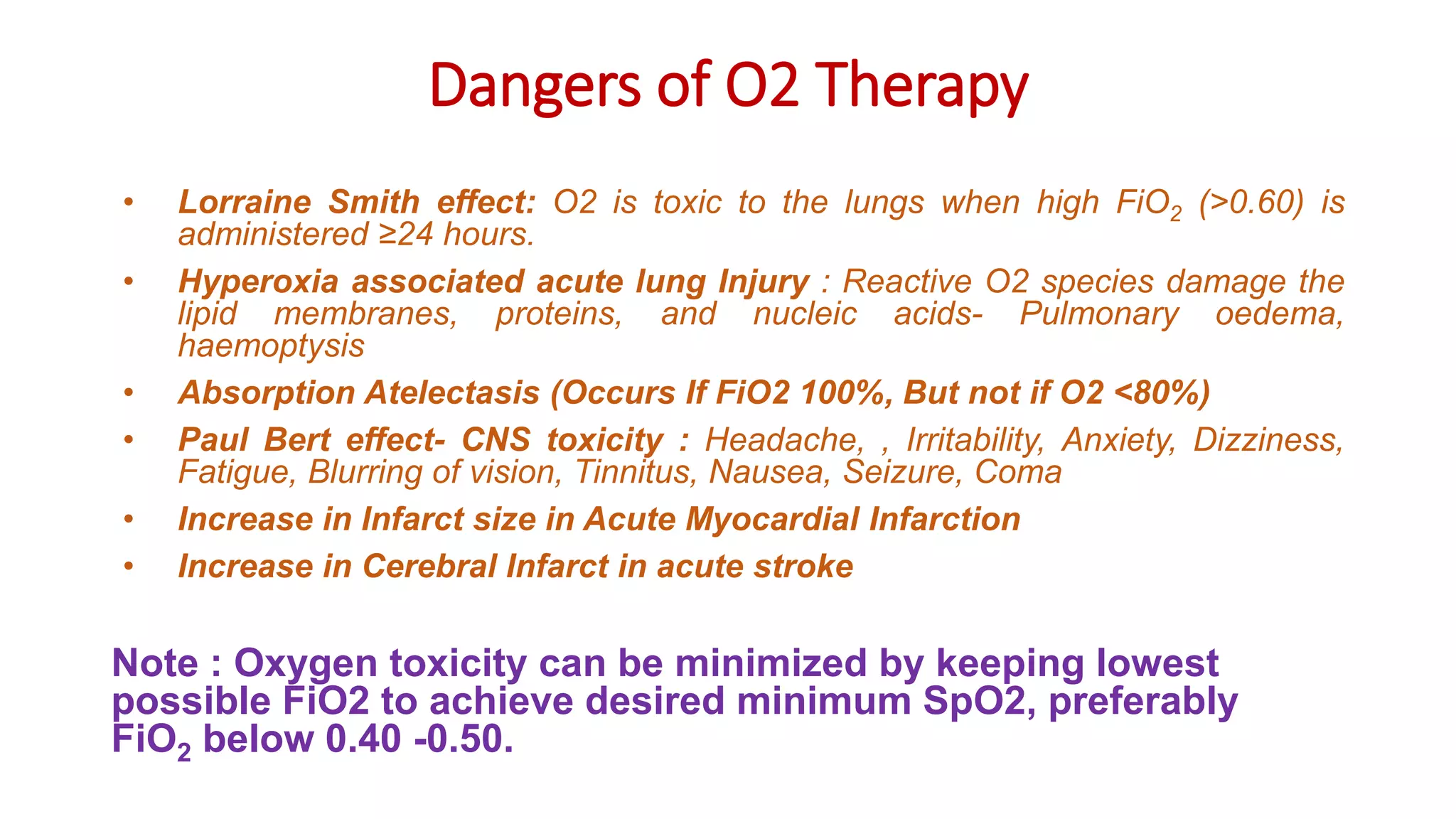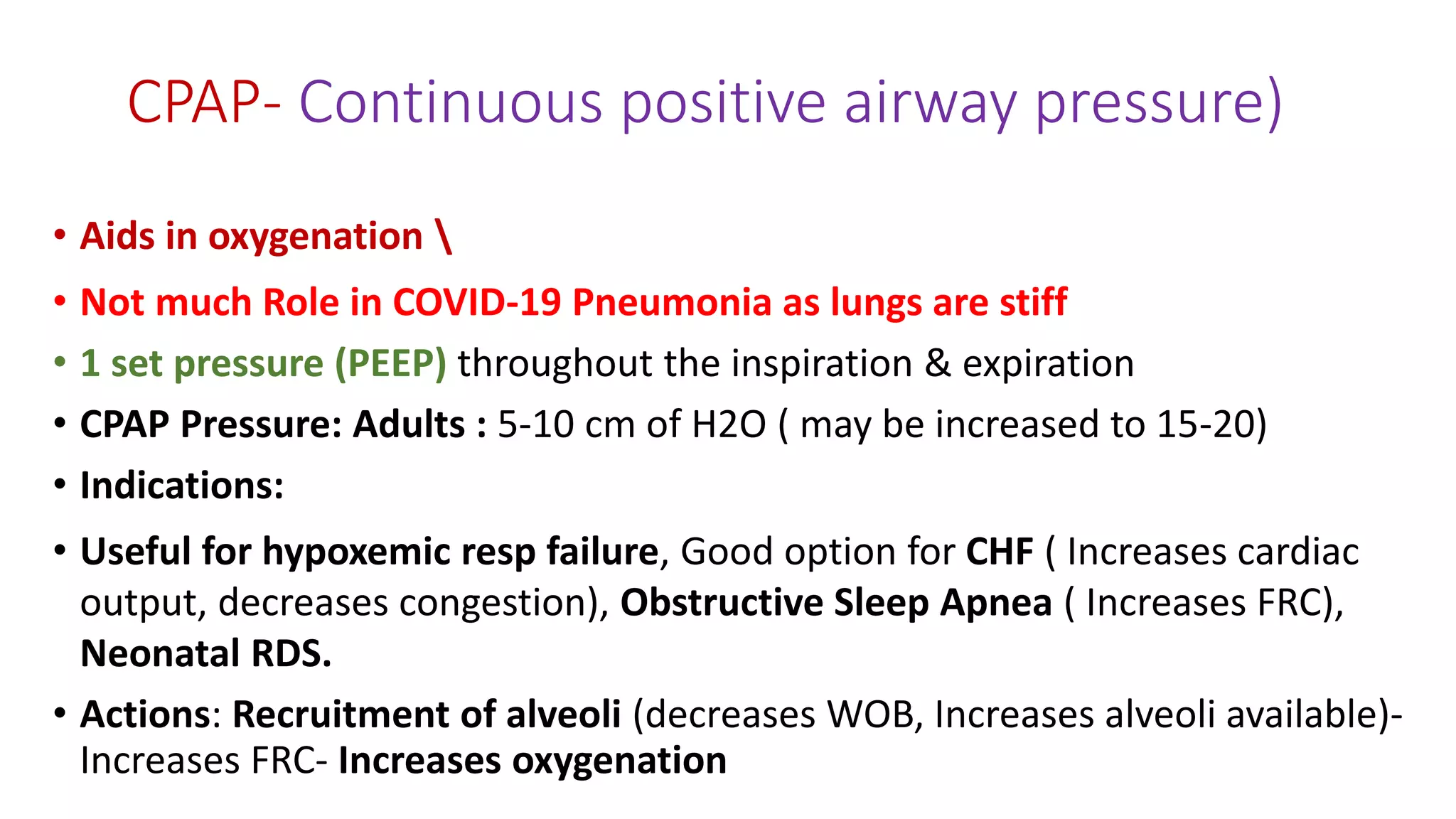Oxygen therapy is recommended for patients with COVID-19 who have moderate to severe disease requiring supplemental oxygen. The document provides guidance on when to start oxygen therapy based on oxygen saturation levels, appropriate oxygen delivery devices and flow rates, targets for oxygen saturation, and considerations for stepping up or down oxygen support. It also discusses monitoring patients on oxygen and recognizing severe hypoxemic respiratory failure that may require non-invasive ventilation or mechanical ventilation.

![Additionally in moderate or severe disease at
high risk of progression
Consider Remdesivir for up to 5 days (200 mg IV on day
1 followed by 100 mg IV OD for next 4 days)
To be started within 10 days of onset of symptoms, in those
having moderate to severe disease with high risk of progression
(requiring supplemental oxygen), but who are NOT on IMV or
ECMO
No evidence of benefit for treatment more than 5 days
NOT to be used in patients who are NOT on oxygen support or in
home setting
Monitor for RFT and LFT (remdesivir not recommended if eGFR
<30 ml/min/m2; AST/ALT >5 times UNL) (not an absolute
contraindication)
Adult patient diagnosed with COVID-19
Dexamethasone 6 mg/day or
equivalent dose of
methylprednisolone (32 mg in 4
divided doses) usually for 5 to 10
days or until discharge, whichever is
earlier.
Patients may be initiated or
switched to oral route if stable
and/or improving
There is no evidence for benefit for
systemic steroids in those NOT
requiring oxygen supplementation,
or on continuation after discharge
Anti-inflammatory or
immunomodulatory therapy (such
as steroids) can have risk of
secondary infection such as invasive
mucormycosis when used at higher
After clinical improvement, discharge
as per revised discharge criteria
AIIMS/ ICMR-COVID-19 National Task Force/ Joint Monitoring Group (Dte.GHS)
Ministry of Health & Family Welfare, Government of India
CLINICAL GUIDANCE FOR MANAGEMENT OF ADULT COVID-19 PATIENTS
Revised on 05/01/2023
Severe disease
Mild disease
Upper respiratory tract symptoms
and/or fever WITHOUT shortness
of breath or hypoxia
Home Isolation & Care
(Refer to relevant guideline)
ADMIT IN WARD ADMIT IN HDU/ICU
saturation (by applying a SpO probe
to fingers)
Stay in contact with treating
physician
MUST DOs
Physical distancing, indoor mask
use, hand hygiene
Symptomatic management
(hydration, anti-pyretics, anti-
tussive)
Monitor temperature and oxygen
2
Moderate disease
Any one of:
1.Respiratory rate ≥24/
min,
breathlessness
2.SpO2
: 90% to ≤ 93% on room air
Oxygen Support:
patients with COPD)
Preferred devices for oxygenation:
non-rebreathing face mask
Awake proning encouraged in all
patients requiring supplemental
oxygen therapy (sequential
position changes every 2 hours)
Anti-inflammatory or
immunomodulatory therapy:
dose or for longer than required
Anticoagulation:
Prophylactic dose of unfractionated
heparin or Low Molecular Weight
Heparin (weight based e.g.,
enoxaparin 0.5mg/kg per day SC).
There should be no
contraindication or high risk of
bleeding
Monitoring:
Clinical Monitoring: Respiratory
rate, Hemodynamic instability,
Change in oxygen requirement
Serial CXR; HRCT chest to be done
ONLY if there is worsening
Lab monitoring: CRP, D-dimer,
blood sugar 48 to 72 hrly; CBC, KFT,
LFT 24 to 48 hrly
Any one of:
1.Respiratory rate >30/min,
breathlessness
2.SpO2 < 90% on room air
Target SpO : 94-96% (88-92% in
2
Seek immediate medical attention if:
Difficulty in breathing or SpO2 ≤ 93%
High grade fever/severe cough,
particularly if lasting for >5 days
A low threshold to be kept for those
with any of the high-risk features*
Respiratory & Cardiovascular Support:
Consider use of NIV (Helmet or face mask
interface depending on availability) in
patients with increasing oxygen
requirement, if work of breathing is LOW
Consider use of HFNC in patients with
increasing oxygen requirement
Intubation should be prioritized in
patients with high work of breathing /if
NIV is not tolerated
Use institutional protocol for ventilatory
management when required
Need for vasopressors to be considered
based on clinical situation
Anti-inflammatory or
immunomodulatory therapy:
Dexamethasone 6 mg/day or equivalent
dose of methylprednisolone (32 mg in 4
divided doses) usually for 5 to 10 days or
until discharge, whichever is earlier. No
evidence for benefit in higher doses.
Anti-inflammatory or immunomodulatory
therapy (such as steroids) can have risk of
secondary infection such as invasive
mucormycosis when used at higher dose
or for longer than required
Anticoagulation:
Prophylactic dose of unfractionated
heparin or Low Molecular Weight Heparin
(weight based e.g., enoxaparin 0.5mg/kg
per day SC). There should be no
contraindication or high risk of bleeding
Supportive measures:
Maintain euvolemia (if available, use
dynamic measures for assessing fluid
responsiveness)
If sepsis/septic shock: manage as per
existing protocol and local antibiogram
Monitoring:
Clinical Monitoring: Work of breathing,
Hemodynamic instability, Change in
oxygen requirement
Serial CXR; HRCT chest to be done ONLY if
there is worsening
Lab monitoring: CRP, D-dimer, blood sugar
48 to 72 hrly; CBC, KFT, LFT 24 to 48 hrly
*High-risk for severe disease or
mortality
Age > 60 years
Cardiovascular disease and CAD
Diabetes mellitus and other
immunocompromised states (such
as HIV)
Active tuberculosis
Chronic lung/kidney/liver disease
Cerebrovascular disease
Obesity
Unvaccinated
Antibiotics should not be used unless
there is clinical suspicion of bacterial
infection
Possibility of coinfection of COVID-19
with other endemic infections must
be considered
Systemic corticosteroids are not
indicated in mild disease
DO NOT USE IN COVID-19
Lopinavir-ritonavir
Hydroxychloroquine
Ivermectin
Neutralizing monoclonal antibody
Convalescent plasma
Molnupiravir
Favipiravir
Azithromycin
Doxycycline
Additionally in rapidly progressing moderate
or severe disease
Consider Tocilizumab preferably within 24-48 hours of onset
of severe disease/ ICU admission [4 to 6 mg/kg (400 mg in 60
kg adult) in 100 ml NS over 1 hour] if the following conditions
are met:
Rapidly progressing COVID-19 not responding adequately
to steroids and needing oxygen supplementation or IMV
Preferably to be given with steroids
Significantly raised inflammatory markers (CRP and/or IL-6)
Rule out active TB, fungal, systemic bacterial infection
Long term follow up for secondary infections (such as
reactivation of TB, flaring of Herpes)](https://image.slidesharecdn.com/oxygentherapyincovid-19-230406015935-36554298/75/Oxygen-Therapy-in-COVID-19-pptx-2-2048.jpg)
![When Oxygen Therapy is Not Required?
• Patients with SpO2 ≥ 92
• Breathless Patients with normal SpO2 [Oxygen is a Treatment of Hypoxemia
not breathlessness]
• COPD patients with SpO2 ≥ 88](https://image.slidesharecdn.com/oxygentherapyincovid-19-230406015935-36554298/75/Oxygen-Therapy-in-COVID-19-pptx-3-2048.jpg)
![When to Start Oxygen Therapy?
• Oxygen therapy is indicated when peripheral oxygen saturation (SpO2) < 92%
[Do not start Oxygen if SpO2 ≥ 92%].
• In patients suffering from Chronic obstructive pulmonary disease, oxygen
therapy is indicated when SpO2 < 88%]-
In COPD patients do not start Oxygen if SpO2 ≥ 88%]
• Awake Proning for 12 - 16 hours per day is recommended when SpO2 starts
falling < 94.
• Hypoxia (SpO2 < 90) is a medical emergency and oxygen administration
should be started immediately.](https://image.slidesharecdn.com/oxygentherapyincovid-19-230406015935-36554298/75/Oxygen-Therapy-in-COVID-19-pptx-4-2048.jpg)
![When to Start Oxygen Supplementation &
Target Range
sPO2 Target sPO2
• Without COPD - < 92 92-96%*
• With COPD - < 88 88-92%
[*Target 94- 96%% in children & pregnant woman]](https://image.slidesharecdn.com/oxygentherapyincovid-19-230406015935-36554298/75/Oxygen-Therapy-in-COVID-19-pptx-5-2048.jpg)





![Oxygen is a drug and should be duly
prescribed recording following details ….
• Baseline SpO2 in Room Air
• Desired SpO2 Target:
- Adults (Target: 92% - 96%)
- COPD patients (Target: 88% - 92%) and
- Pregnant women and children (Target: 94% - 96%)
• Oxygen administration device to be used- nasal-prongs, or simple
oxygen face mask, or Non-Rebreathing Mask [NRBM}, or Venturi
mask, or High Flow Nasal Cannula [HFNC] etc.](https://image.slidesharecdn.com/oxygentherapyincovid-19-230406015935-36554298/75/Oxygen-Therapy-in-COVID-19-pptx-11-2048.jpg)




![Recognize Severe Hypoxemic Respiratory
Failure while on Standard O2 Rx
For patients who continue to deteriorate despite using NRBM mask (flow rates of 10–15 L/min FiO2 0.95) perform ABG
Analysis.
ABG Analysis :- Normal pH (7.35-7.45), PaO2 (80-100 mmHg), PaCO2 (35-45 mm HG), HCO3- (22 -26 mEq/L)
Step 1 : Analyze pH: < 7.35 Acidosis; > 7.45 : Alkalosis
Step 2: Analyze PaCO2: < 35 Resp. Alkalosis ; > 45 Resp. Acidosis
Step 3: Analyze HCO3- : <22 Met. Acidosis; > 26 Met. Alkalosis
Respiratory Failure Two Types:
• Type 1 Respiratory failure [ PaO2 < 60 mmHg with Normal PaCO2 or Reduced Pa CO2]: Hypoxia : HFNO: Start High Flow
Nasal Oxygen (HFNO) to reduce the need for mechanical ventilation by intubation. Adult HFNO systems (max flow up to 60
L/min of gas flow and FiO2 up to 1.0) and Pediatric circuits max flow up to 25 L/min.
Patients receiving HFNO should be given 1 hour trial, but if condition deteriorates should be put on mechanical
intubation
• Type 2 Respiratory Failure [PaCO2>50 mmHg with paO2 <60 mm HG] : Hypoxia with Hypercapnia: O2 Support by BiPAP ( If
patient is conscious and there is no hemodynamic instability) , Mechanical Ventilation (if hemodynamic instability,
multiorgan failure, abnormal mental status)](https://image.slidesharecdn.com/oxygentherapyincovid-19-230406015935-36554298/75/Oxygen-Therapy-in-COVID-19-pptx-16-2048.jpg)





















